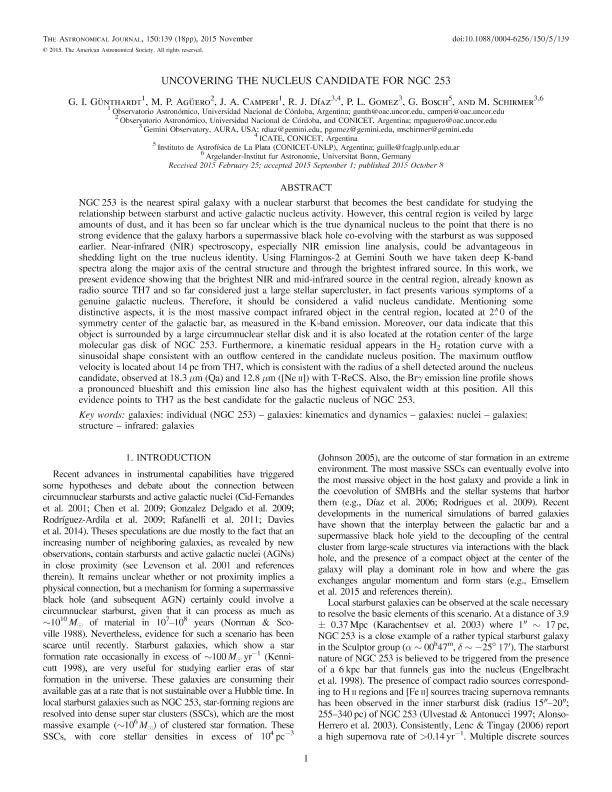Mostrar el registro sencillo del ítem
dc.contributor.author
Gunthardt, Guillermo Ivan

dc.contributor.author
Agüero, Maria Paz

dc.contributor.author
Camperi, Javier Antonio

dc.contributor.author
Diaz, Ruben Joaquin

dc.contributor.author
Gomez, P. L.
dc.contributor.author
Bosch, Guillermo Luis

dc.contributor.author
Schirmer, M.
dc.date.available
2019-02-08T18:07:47Z
dc.date.issued
2015-11
dc.identifier.citation
Gunthardt, Guillermo Ivan; Agüero, Maria Paz; Camperi, Javier Antonio; Diaz, Ruben Joaquin; Gomez, P. L.; et al.; Uncovering the nucleus candidate for NGC 253; IOP Publishing; Astronomical Journal; 150; 5; 11-2015; 1-18; 139
dc.identifier.issn
0004-6256
dc.identifier.uri
http://hdl.handle.net/11336/69778
dc.description.abstract
NGC 253 is the nearest spiral galaxy with a nuclear starburst that becomes the best candidate for studying the relationship between starburst and active galactic nucleus activity. However, this central region is veiled by large amounts of dust, and it has been so far unclear which is the true dynamical nucleus to the point that there is no strong evidence that the galaxy harbors a supermassive black hole co-evolving with the starburst as was supposed earlier. Near-infrared (NIR) spectroscopy, especially NIR emission line analysis, could be advantageous in shedding light on the true nucleus identity. Using Flamingos-2 at Gemini South we have taken deep K-band spectra along the major axis of the central structure and through the brightest infrared source. In this work, we present evidence showing that the brightest NIR and mid-infrared source in the central region, already known as radio source TH7 and so far considered just a large stellar supercluster, in fact presents various symptoms of a genuine galactic nucleus. Therefore, it should be considered a valid nucleus candidate. Mentioning some distinctive aspects, it is the most massive compact infrared object in the central region, located at 2.″0 of the symmetry center of the galactic bar, as measured in the K-band emission. Moreover, our data indicate that this object is surrounded by a large circumnuclear stellar disk and it is also located at the rotation center of the large molecular gas disk of NGC 253. Furthermore, a kinematic residual appears in the H2 rotation curve with a sinusoidal shape consistent with an outflow centered in the candidate nucleus position. The maximum outflow velocity is located about 14 pc from TH7, which is consistent with the radius of a shell detected around the nucleus candidate, observed at 18.3 μm (Qa) and 12.8 μm ([Ne ii]) with T-ReCS. Also, the Brγ emission line profile shows a pronounced blueshift and this emission line also has the highest equivalent width at this position. All this evidence points to TH7 as the best candidate for the galactic nucleus of NGC 253.
dc.format
application/pdf
dc.language.iso
eng
dc.publisher
IOP Publishing

dc.rights
info:eu-repo/semantics/openAccess
dc.rights.uri
https://creativecommons.org/licenses/by-nc-sa/2.5/ar/
dc.subject
Galaxies: Individual (Ngc 253)
dc.subject
Galaxies: Kinematics And Dynamics
dc.subject
Galaxies: Nuclei
dc.subject
Galaxies: Structure
dc.subject
Infrared: Galaxies
dc.subject.classification
Astronomía

dc.subject.classification
Ciencias Físicas

dc.subject.classification
CIENCIAS NATURALES Y EXACTAS

dc.title
Uncovering the nucleus candidate for NGC 253
dc.type
info:eu-repo/semantics/article
dc.type
info:ar-repo/semantics/artículo
dc.type
info:eu-repo/semantics/publishedVersion
dc.date.updated
2019-02-07T14:48:43Z
dc.journal.volume
150
dc.journal.number
5
dc.journal.pagination
1-18; 139
dc.journal.pais
Reino Unido

dc.journal.ciudad
Londres
dc.description.fil
Fil: Gunthardt, Guillermo Ivan. Universidad Nacional de Córdoba. Observatorio Astronómico de Córdoba; Argentina
dc.description.fil
Fil: Agüero, Maria Paz. Universidad Nacional de Córdoba. Observatorio Astronómico de Córdoba; Argentina. Consejo Nacional de Investigaciones Científicas y Técnicas. Centro Científico Tecnológico Conicet - San Juan. Instituto de Ciencias Astronómicas, de la Tierra y del Espacio. Universidad Nacional de San Juan. Instituto de Ciencias Astronómicas, de la Tierra y del Espacio; Argentina
dc.description.fil
Fil: Camperi, Javier Antonio. Universidad Nacional de Córdoba. Observatorio Astronómico de Córdoba; Argentina
dc.description.fil
Fil: Diaz, Ruben Joaquin. Gemini Observatory; Chile. Consejo Nacional de Investigaciones Científicas y Técnicas. Centro Científico Tecnológico Conicet - San Juan. Instituto de Ciencias Astronómicas, de la Tierra y del Espacio. Universidad Nacional de San Juan. Instituto de Ciencias Astronómicas, de la Tierra y del Espacio; Argentina
dc.description.fil
Fil: Gomez, P. L.. Gemini Observatory; Chile
dc.description.fil
Fil: Bosch, Guillermo Luis. Consejo Nacional de Investigaciones Científicas y Técnicas. Centro Científico Tecnológico Conicet - La Plata. Instituto de Astrofísica La Plata. Universidad Nacional de La Plata. Facultad de Ciencias Astronómicas y Geofísicas. Instituto de Astrofísica La Plata; Argentina
dc.description.fil
Fil: Schirmer, M.. Gemini Observatory; Chile. Universitat Bonn; Alemania
dc.journal.title
Astronomical Journal

dc.relation.alternativeid
info:eu-repo/semantics/altIdentifier/doi/http://dx.doi.org/10.1088/0004-6256/150/5/139
dc.relation.alternativeid
info:eu-repo/semantics/altIdentifier/url/https://iopscience.iop.org/article/10.1088/0004-6256/150/5/139/meta
dc.relation.alternativeid
info:eu-repo/semantics/altIdentifier/url/https://arxiv.org/abs/1509.00330
Archivos asociados
